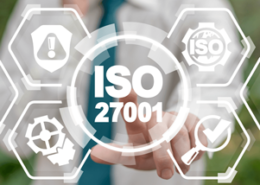I. Introduction
A. Navigating the Digital Landscape: Understanding Information Security Dynamics
In our ever-evolving digital realm, the significance of information security cannot be overstated. Individuals, organizations, and governments face an array of threats, from unauthorized access to data breaches and cyber-attacks. The need to protect sensitive information has spurred the creation of robust frameworks, with ISO 27001 at the forefront.
Information security encompasses a holistic approach, involving policies, processes, technologies, and awareness programs. As technology advances, so do cyber threats, necessitating comprehensive measures to maintain trust, confidentiality, and organizational functionality.
B. The Catalyst for Security: ISO 27001 Certification’s Crucial Role
ISO 27001, a global standard for Information Security Management Systems (ISMS), is pivotal in fortifying defenses against cyber threats. Achieving this certification is not just a badge of credibility; it signifies a commitment to international best practices in information security management.
Key benefits of ISO 27001 certification include effective risk management, legal and regulatory compliance, enhanced customer trust, and a competitive advantage in the business landscape.
C. Blog’s Mission
This blog aims to delve into information security, emphasizing ISO 27001’s significance. Through insightful discussions, we empower readers with a comprehensive understanding of the evolving threat landscape. Whether you’re a professional, business owner, or an individual concerned about data security, this blog provides valuable insights into information security and ISO 27001’s pivotal role.
II. Understanding ISO 27001
A. Decoding the ISO 27001 Standard
ISO 27001 sets criteria for establishing, implementing, maintaining, and improving an Information Security Management System (ISMS). The ISMS ensures confidentiality, integrity, and availability of sensitive information. The standard is not prescriptive about specific controls but focuses on a risk management process tailored to the organization’s context.
B. Key Principles and Requirements
1. Risk-Based Approach: Navigating Threats Systematically
ISO 27001 mandates identifying, assessing, and treating information security risks systematically. This involves evaluating threats, determining their impact, and implementing controls for mitigation.
2. Leadership Commitment: Guiding Information Security Initiatives
Top management’s active support aligns the ISMS with strategic objectives. Leadership commitment is paramount for fostering a security-oriented organizational culture.
3. Integration into Business Processes: A Holistic Approach
ISO 27001 encourages embedding information security into overall business functions. It’s not a standalone initiative but an integral part of organizational processes.
C. Adapting to Emerging Threats: A Continuous Improvement Cycle
ISO 27001 emphasizes continual improvement. Regular assessments identify opportunities for enhancement, ensuring the ISMS evolves with changing threats and business environments.
D. Comprehensive Documentation and Management Reviews
The standard mandates a thorough approach to documentation, including policies and procedures. Internal audits and management reviews are crucial for assessing compliance and ensuring ongoing effectiveness.
III. Benefits of Compliance
Complying with ISO 27001 certification yields multifaceted benefits that extend beyond demonstrating adherence to standards. Enhanced information security posture, instilled confidence in stakeholders, and a benchmark for excellence are among the primary advantages.
By aligning with ISO 27001, organizations not only fortify their defenses but also establish credibility and trust in the marketplace. This commitment resonates with clients, partners, and regulatory bodies, positioning certified entities as leaders in information security.
In understanding and adhering to ISO 27001 principles, organizations can bolster their defenses and reap the benefits associated with compliance. The subsequent section explores the process of implementing ISO 27001, guiding organizations on the path to certification.
IV. Implementing ISO 27001: A Strategic Approach
A. Crafting Your Information Security Blueprint
Implementing ISO 27001 involves a strategic blueprint tailored to your organization’s unique landscape. Begin by conducting a thorough risk assessment to identify potential vulnerabilities and threats. This forms the foundation for designing controls and measures aligned with ISO 27001 standards.
B. Establishing the Information Security Management System (ISMS)
Central to ISO 27001 implementation is the establishment of the ISMS. This involves creating documented policies, procedures, and guidelines that adhere to ISO 27001 principles. Ensure clear communication and understanding across all levels of the organization, fostering a culture of information security.
C. Employee Training and Awareness
A crucial aspect often overlooked is the human element. Conduct comprehensive training programs to ensure all employees understand their roles in maintaining information security. Foster a culture where every team member recognizes their responsibility in safeguarding sensitive information.
V. The Certification Process
A. Preparing for External Audit
Before the external audit, conduct internal audits to identify and rectify potential gaps in compliance. This proactive approach ensures a smoother external audit process. Engage employees at all levels in the audit process to create a sense of ownership and accountability.
B. Selecting a Reputable Certification Body
Choosing the right certification body is paramount. Research and select a reputable body accredited to grant ISO 27001 certification. This decision significantly impacts the credibility and recognition of your certification in the global marketplace.
C. Ongoing Compliance and Improvement
Achieving ISO 27001 certification is not the end but the beginning of a commitment to continuous improvement. Regularly review and update your ISMS, adapting to new threats and changes in the business environment. Maintain ongoing compliance through internal audits and management reviews.
VI. Ensuring ISO 27001 Success
A. Strategic Integration into Business Processes
Successful ISO 27001 implementation involves seamlessly integrating information security into daily operations. Align the ISMS with existing business processes, making it an organic part of how your organization operates.
B. Embracing a Culture of Security
Beyond policies and procedures, cultivate a culture where every employee values and prioritizes information security. This involves ongoing training, awareness programs, and leadership reinforcement of the organization’s commitment to security.
C. Celebrating Milestones and Recognitions
Upon achieving ISO 27001 certification, celebrate the milestone within your organization. Showcase your commitment to information security in marketing materials and communications. Leverage the certification to enhance your brand image and reputation in the industry.
VII. Conclusion
A. A Secure Future with ISO 27001
In conclusion, ISO 27001 certification is not merely a checkbox but a strategic investment in the security and credibility of your organization. By understanding and implementing its principles, you fortify your defenses against evolving threats, gain a competitive advantage, and reassure stakeholders of your commitment to information security.
Embark on this journey with a clear roadmap, integrating information security seamlessly into your organizational DNA. Celebrate your successes, learn from challenges, and continually adapt to the dynamic landscape of information security. With ISO 27001 as your guiding force, you pave the way for a secure digital future.





тест 1.